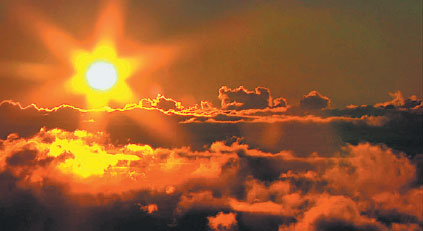Maui curbs crowds for its 'top of the world' sunrise view
(China Daily) Updated: 2017-03-06 07:14HALEAKALA NATIONAL PARK, Hawaii - Well before dawn each morning, throngs of tourists from around the world make their way to Maui's tallest peak, a dormant volcano, to see what Mark Twain called the "sublimest spectacle" he ever witnessed.
They drive up a long, winding road through the clouds to an otherworldly, lava-rock landscape at more than 3,000 meters. Then they bundle up and take their place for a dazzling daybreak show, watching the sun peek out from the horizon and saturate the sky with endless shades of yellow, orange and red.
Over the past year, the sunrise view from atop Haleakala - Hawaiian for House of the Sun - has been attracting over a thousand people a day. The result, officials say, was a logjam of cars spilling out of the parking lots and onto the road, creating a safety hazard, and footsteps trampling sensitive habitat.
To address the problem, the National Park Service recently started requiring reservations and limiting the number of vehicles to the volcano's 150 available parking spaces, potentially cutting in half the number of early-morning visitors.
Sunrise viewing has long been popular at Haleakala, one of the main attractions at Haleakala National Park, despite morning temperatures that often dip to around freezing. Red soil and lava rocks dominate the summit, and only a few hardy plants have adapted to its harsh, high-altitude conditions. The peak also is home to the nene, the Hawaiian goose, and colonies of spiders that feast on bugs blown in from the surrounding wilderness.
Overcrowding started becoming a problem roughly 15 years ago, park superintendent Natalie Gates says. About a year ago, it got worse, likely as more people learned about the stunning sunrise views from images posted on Facebook and other social media sites.
Though only 16 percent of park visitors come at sunrise, they account for 40 percent of the park's emergency medical calls.
"It's a dark place. It's rocky. And when people are moving away from crowds and trying to go off trail, often frequently stumbling around on cliff sides in the dark, we see trauma cases, altitude cases," Gates says. "We sometimes see cardiac and other cases."
Straying humans also trample on seedlings and root systems of the Haleakala silversword, a rare, bush-like plant with thick leaves. And they can disturb the ground nests of the Hawaiian petrel, an endangered seabird.
Under the new system, only those driving to the summit between 3 and 7 am need reservations, which cost $1.50 per car plus the $20 park entrance fee.
The system closes to sunrise viewers after owners of the allotted 150 vehicles per morning have made their reservations. The proceeds will pay for the expense of administering the reservation program. People on guided tours won't be affected as tour companies fall under different regulations.
Nettie Kuwamura, a native Hawaiian who was born and raised on Maui, considers herself a protector of the summit. She reminds tourists to stay off the lava rocks and away from fragile areas.
"I'm passionate about this island. I'm passionate about this mountain," Kuwamura says. "It's a very sacred mountain to the Hawaiians."
For the past two years, Kuwamura has been driving tourists to the summit, where she recites a Hawaiian chant to welcome the rising sun each morning.
"Once the sun comes up, that's when the beauty comes up," she says.
Associated Press
|
The sun rises over the clouds in front of the summit of Haleakala volcano in Haleakala National Park on Hawaii's island of Maui. Sunrise on Haleakala attracts over 1,000 people a day. Associated Press |
- 'Cooperation is complementary'
- Worldwide manhunt nets 50th fugitive
- China-Japan meet seeks cooperation
- Agency ensuring natural gas supply
- Global manhunt sees China catch its 50th fugitive
- Call for 'Red Boat Spirit' a noble goal, official says
- China 'open to world' of foreign talent
- Free trade studies agreed on as Li meets with Canadian PM Trudeau
- Emojis on austerity rules from top anti-graft authority go viral
- Xi: All aboard internet express












